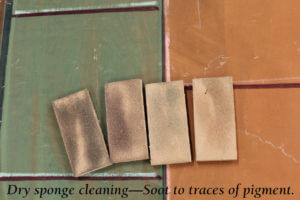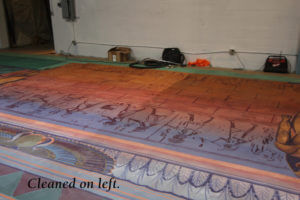Behind the Scenes
May 5, 2017
With its ornate proscenium and plush seating, the Ives Auditorium’s jewel box décor and elegance harkens back to the golden age of theater. As plans shaped for the Auditorium’s design, the Minnesota Masonic Heritage Center acquired a large collection of hand-painted Scottish Rite theatre drops that were made available from the sale of the Valley of Fort Scott Scottish Rite building in Kansas. It was a wonderful find: the collection allows the Center to provide the necessary scenes for Scottish Rite degree work in the new Ives Auditorium, as well as offer audiences beautiful and historic settings for performances and events.
Painted by noted scenic artist, Thomas Moses, in the first half of the 20th Century, the collection includes multiple-piece scenes that can be displayed to give a three-dimensional stage presentation. These scenes range from elaborate cathedral renderings to rolling pastoral settings.
To accommodate the size of the collection—numbering more than 70 drops—the Auditorium’s stage depth was extended by 10 feet and proprietary rigging developed to hang and store the scenes. Today, many complete scenes are rigged and stored on the Ives stage, and the meticulous work of stabilizing and hanging the remaining drops is well underway.
A great deal of time and effort has gone into making the Fort Scott drops available as an amenity of the Ives. Here’s a look at the intensive process, and the expertise needed to get the job done right.
Setting the Stage
The Fort Scott drops arrived in Minnesota from Kansas in November 2015. All were dirty and topped with layers of soot and other contaminants that had accumulated over their 91-year lifespan. Most of the scenes were also “dusting,” or losing pigment, an unfortunate byproduct of aging and moving/handling. Because the drops were intended to be used as props, not artifacts, the emphasis of their restoration focused on properly stabilizing and preserving the pieces so that they could be hung and enjoyed.

Lead Scenic Artist, Kimberly L. Lawler, was brought in to assess, stabilize, repair and install the collection. Her 30 years of experience creating and restoring theatre sets and scenes ensured the absolute integrity of the project. Mia Schillace Nelson, creative director and co-owner of Outhouse Exhibit Services, was contracted as the project administrator. Mia was also project lead for design and installation of the Colonel James B. Ladd Museum and Charles Nelson Library at the Center. The two employed an army of rigging and restoration specialists to support their meticulous work.
Dropping the Batten
The original old-growth cedar battens used to clamp each drop in place at Fort Scott were delivered to the Ives Auditorium with the hope that they could be preserved and reused. The thought was to hang the 43-foot battens on center in the 38-foot rigging system and allow them to overhang on each end. However, as the team started unpacking the battens, it became clear that this plan posed a few problems. For starters, several of the wooden battens had cracked or broken. The overhanging ends posed a serious safety concern, threatening to tangle or tear the rigging and other electrical lines in the wings.
In addition, most rigging systems allow for six-to-eight inches between batten centers. To accommodate the sheer number of drops in the Ives collection, the specially designed rigging system allowed for only three inch centers. Such tight quarters meant the thick wooden battens would hang a mere 1.5 inches apart, allowing no room for future warping and increasing the risk of snagging neighboring lines or damaging the drops.
After a great deal of deliberation, the rigging experts and the team decided to hang the historic drops using a modern webbing and pipe pocket configuration instead of the wooden battens. The approach would also allow for less stress to the drops, as the lightweight conduit in the pipe pockets would not weigh as heavily on their aging muslin.
Yet another problem immediately presented itself: as Kimber and her crew began unwrapping and unrolling the historic drops, they noted that they had been inaccurately sized upon their purchase. Initial reports documented their width at 38 feet. In fact, the majority of the drops stretched 43 feet wide, too long for the 38-foot lines from which they would hang, and much too wide for the 32-foot opening of the Ives’ proscenium. In addition to restoring and preparing each drop for a new hanging configuration, the team would have to trim the delicate drops if they were ever to be displayed.
Detailed Work
Stabilizing and hanging each drop requires hours of detailed work to carefully trim, clean, repair and install them. Here are the steps the Heritage Center team takes for each and every one:
- Trimming: The team first lays out each scene in its original configuration—one on top of the other — to find the best line for trimming the drops to fit the Ives stage and rigging system. Trimming work is slow and meticulous so that the scene remains in proportion and hangs properly.

- Cleaning and Structural Repair: Team members remove a century of soot by hand using special dry-chemical sponges. They make several passes until the black soot is gone and traces of pigment are visible on the sponge. Care must be taken not to remove too much pigment. While cleaning, the team repairs any rips or holes with pre-shrunk muslin or canvas flex-glued to the back of the drop around the tear, taking care not to let excess moisture seep through to the front.
- Sealing: Because it was an inexpensive option at the time, scenic painters like Moses used distemper paint for their pieces. This type of paint was a mixture of water, animal glue, whiting and pigment. Loose pigment is re-adhered by sealing the entire drop with a solution of animal glue and water along with a separate solution of fire retardant.

- Sewing: It takes a 44-foot sewing table and two people, one sewing and one pushing the drop on rollers, to add top webbing and a pipe pocket to each drop. Three layers of 3/8-inch stitching in the webbing is used to help retain the integrity of the delicate muslin after it is hung. Rather than position them the standard 12 inches apart, grommets are placed six inch apart in the webbing to better distribute the hanging stress across the top. The drop is moved to the table by carefully wrapping it around packing peanut-filled garbage bags tied together like a giant sausage link. This mitigates much of the damage to the paint caused by creasing the material.
- Installing: To hang each drop, team members thread ties through the grommets and secure them—one by one—on to the 38-foot fly batten.
Scenes to be Seen
Already, several of the stunning Fort Scott collection drops have been used at the Ives Auditorium to augment a performance or Masonic ritual work. By the end of May 2017, 27 drops will hang above the stage, and restoration will continue on the rest. As painstaking as the project has been, it has become a labor of love for the small, dedicated team whose job it is to bring the scenery back to life.
“To have found such a wonderful collection of historic Masonic drops is tremendous,” said project lead, Mia Schillace Nelson. “To be able to restore it and present it to the public once again is a privilege.”
Come explore the history of Freemasonry and the elegance of Minnesota Masonic Heritage Center!
Museum Hours of Operation:
Monday Closed
T – F 10 a.m. to 5 p.m.
Sat noon to 5 p.m.
Sun noon to 3 p.m.
Schedule a Tour
Attend a Performance




